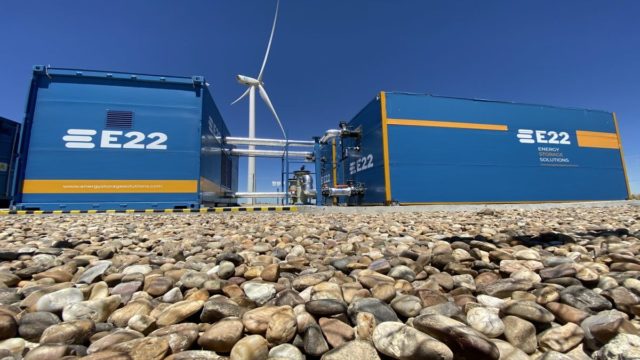In ASX clean energy news this morning, Australian Vanadium Ltd (ASX:AVL) has done a deal with IGO Ltd (ASX:IGO) based on its vanadium redox flow battery (VRFB) energy storage technology.
AVL’s 100% owned subsidiary, VSUN Energy, has signed an agreement with IGO Ltd to install a standalone power system (SPS) utilising VRFB for the Nova nickel operation in Western Australia’s Fraser Range.
An SPS supplies power independently to the electricity grid and comprises a combination of solar, wind, battery and backup generation from diesel or gas.
The SPS being installed at IGO’s nickel operation will be based around a 300kWh VRFB from Spanish manufacturer E22.
Shares in AVL jumped 13.04pc on the news this morning.
Project to provide 100pc renewable energy supply
AVL said the system has been designed to provide a 100pc renewable energy supply for much of the year, with periods of long cloud cover being supported by a diesel genset.
Total renewable penetration of 85-90% is being targeted for the trial of the VRFB based SPS system, with the SPS re-deployable for use on multiple mines sites and locations over its 20+ year service life.
The target of long periods with diesel-off will not only significantly reduce the carbon emissions of diesel generator powered bore fields, but also offer substantial reductions in operating hours for service personnel.
AVL says these two significant benefits indicate a potentially rapid growth market segment for this robust technology.
Enabling diesel to be almost entirely eliminated
AVL managing director Vincent Algar said working with IGO on this project will accelerate the objectives of the companies — and the broader mining industry — towards carbon neutrality.
“The robustness of VRFB energy storage makes it perfectly suited to the tough environments found on many Australian mine sites,” he said.
“The installation of an SPS based on vanadium technology for pumping applications enables diesel to be almost entirely eliminated, helping reduce overall carbon emissions and providing reliable green power.”
IGO chief operating officer Matt Dusci said the company aspires to be carbon neutral across its business and to do this by leveraging renewable energy solutions and innovation to reduce emissions at its remote exploration and mining operations.
VRFB’s can be recycled tens of thousands of times
This agreement with IGO will end 12 months from the date of system commissioning and first power production, unless extended or terminated in accordance with the agreement.
The SPS is being provided to IGO at no charge, with the option to purchase or rent the system at the end of the trial period.
It is expected that the project will enable IGO to analyse the performance of the SPS for potential use in its dewatering and bore pumps systems.
VRDFBs are well suited as an SPS due to the following attributes:
- Non-flammable – safe to be operated in areas prone to bushfire and other sensitive areas;
- High cycle life – the VRFB can be cycled tens of thousands of times with virtually no degradation in capacity. With a lifespan exceeding 20 years, the VRFB has longevity that matches renewable energy generation sources such as solar PV and will not require replacement multiple times over the life of a project;
- Sustainability – at the end of the project, the VRFB can be fully recycled. The power unit of the battery can be recycled whilst the electrolyte can either be reused in another battery or have the vanadium reclaimed for use within the steel industry;
- High temperature tolerance – the VRFB has a wider operating temperature range than most other energy storage technologies, giving it the ability to be deployed in all regions of Australia; and
- Flexibility – the VRFB can be used in a variety of roles over its lifespan and is only limited by the control system being used.
Tlou Energy’s hydrogen production project
Elsewhere, Tlou Energy (ASX:TOU) is up 50pc today on news that it has secured a 10MW power purchase agreement (PPA) with Botswana Power Corporation to help displace existing carbon-intensive power at its Lesedi Power Project on the Northern Cape of South Africa.
This prototype hydrogen production unit is being designed, built, and tested in Brisbane prior to transportation to Lesedi in the first half of 2022 when production trials will begin.
The construction of transmission lines to connect Lesedi to the existing power grid is expected to be complete in 2023.
TLOU says the production of hydrogen and solid carbon products could allow the company to achieve early-stage revenue ahead of gas-to-power revenue under the 10MW PPA.
Net Zero emissions potential
Once the prototype arrives at Lesedi it will utilise Tlou’s existing gas flows to produce hydrogen and solid carbon-by products.
TOU says net zero emissions potential will be achieved following the planned addition of solar PV energy.
The use of plasma technology for hydrogen production will be a first for the sub‐Saharan region and could have major implications for the production of low emissions, clean energy across the region – similarly in the related fields of waste‐to‐energy and waste disposal.
TOU’s hydrogen technology partner Synergen Met Pty Ltd has completed preliminary engineering works for the hydrogen-carbon production process, and the plasma torch will be tested and configured to optimise the hydrogen and solid carbon production.
You might be interested in












